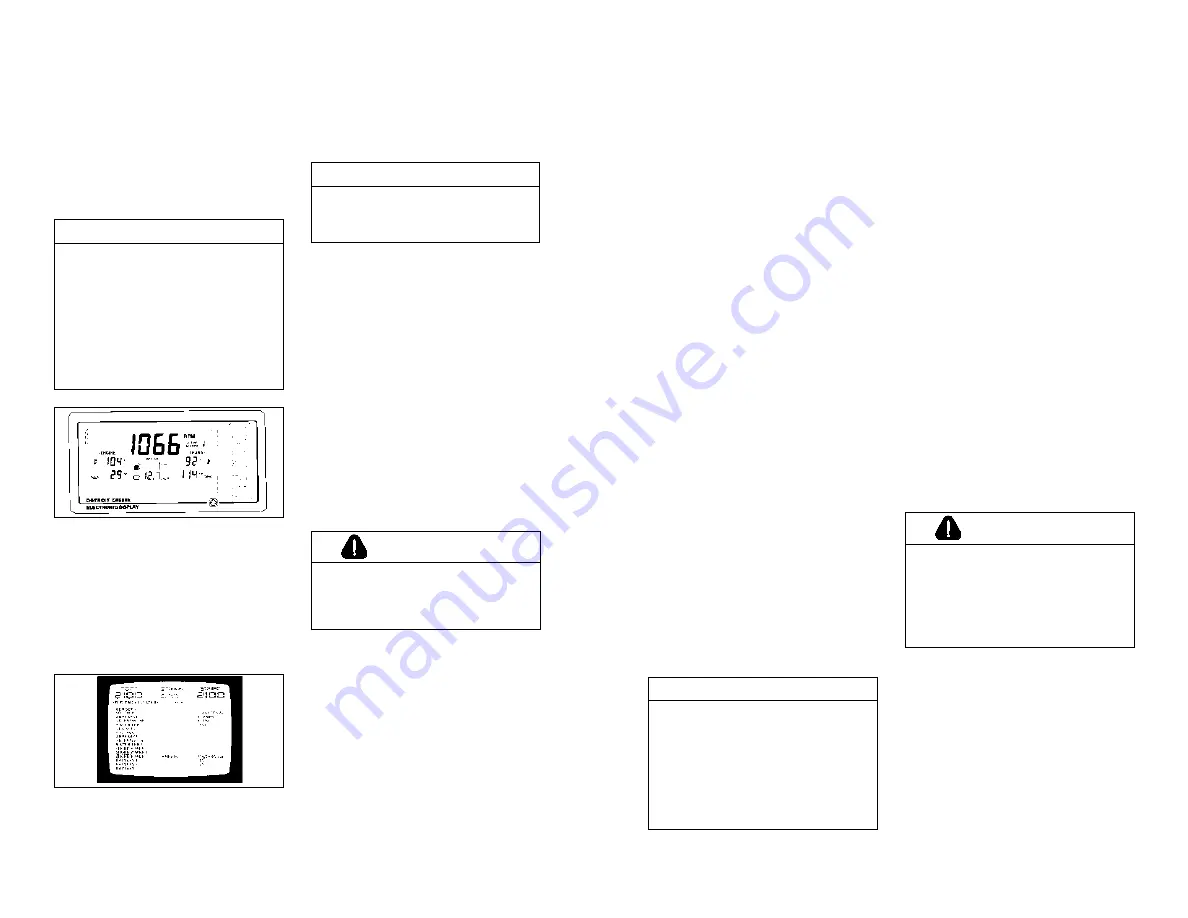
9
8
2. Start the engine after the lights go
out. Start the engine by pressing
the starter switch firmly.
If the engine fails to start within 15
seconds, release the starter switch
and allow the starting motor to cool for
15 seconds before trying again. If the
engine fails to start after four attempts,
an inspection should be made to
determine the cause.
Running the Engine
Oil Pressure
Observe the oil pressure gauge or elec-
tronic display immediately after starting
the engine. A good indicator that all of the
moving parts are getting lubrication is
when the oil pressure gauge registers
pressure (5 psi - 34.5 kPa) at idle speed.
If there is no oil pressure indicated within
10 to 15 seconds, stop the engine and
check the lubricating system. The pres-
sure should not fall below 28 psi (193
kPa) at 1800 rpm, and normal operating
pressure should be higher. If pressure
does not fall within these guidelines, it
should be checked with a manual gauge.
Warm-up
Run the engine at part throttle for about
five (5) minutes to allow it to warm up
before applying a load.
Inspection
Transmission, Marine Gear—
While
the engine is idling, check the transmis-
sion or marine gear for proper oil level
and add oil as required. On marine
engines check that water is flowing out
the exhaust pipe or raw water dis-
charge pipe. Look for coolant, fuel, or
lubricating oil leaks at this time. If any
are found, shut down the engine imme-
diately and have leaks repaired after the
engine has cooled.
Cooling System–
Entrapped air
must
be purged after the cooling system is
filled. To do this allow the engine to
warm up without the pressure cap
installed. With the transmission or marine
gear in neutral, increase engine rpm
above 1000 rpm and add coolant as
required. Vent the petcock on the water
return line at the water-jacketed tur-
bocharger (if used) until coolant (no air)
comes out. Install the pressure cap after
the coolant level has stabilized at the
bottom of the radiator or heat exchanger
tank filler neck. Refill the recovery bottle
as needed if coolant is drawn into the
engine while purging the air.
If all of the coolant is drawn out of the
recovery bottle when the engine cools,
remove the pressure cap from the radi-
ator or heat exchanger and check to
make sure the coolant level is at the
bottom of the filler neck. Add coolant as
required, replace the pressure cap,
and fill the recovery bottle to the "Full
Cold" level, or no more than one-quarter
of its volume.
Crankcase—
If the engine oil was
replaced, stop the engine after normal
operating temperature has been
reached. Allow the oil to drain back into
the crankcase for approximately twenty
(20) minutes, and check the oil level. If
necessary, add oil to bring the level to
the proper mark on the dipstick. Use
only the heavy-duty oils recommended
in
How to Select Lubricating Oil
(page
45) in this guide.
Turbocharger—
Make a visual inspec-
tion of the turbocharger for oil leaks,
coolant leaks, exhaust leaks, excessive
noise or vibration. Stop the engine imme-
diately if a leak or unusual noise or vibra-
tion is noted.
Do not restart the engine
until the cause of the concern has
been investigated and corrected.
Authorized Detroit Diesel service outlets
are properly equipped to perform this
service.
Avoid Unnecessary Idling
During long engine idling periods with
the transmission in neutral, the engine
coolant temperature may fall below the
normal operating range. The incomplete
combustion of fuel in a cold engine will
cause crankcase oil dilution, formation
of lacquer or gummy deposits on the
valves, pistons, and rings, and rapid
accumulation of sludge in the engine.
When prolonged idling is necessary,
maintain at least 800-1000 rpm.
Electronic Display Module
DDEC Imaging System
NOTICE:
If the warning lights on the BBIM stay
on, or if they do not come on
momentarily after turning on the igni-
tion key, consult with a DDEC ser-
vice technician. In the former case
the bridge displays will show the
active fault codes. Operating the
engine under these circumstances
may result in engine damage.
NOTICE:
To prevent starting motor damage,
do not press the starter switch again
after the engine has started.
CAUTION:
To avoid personal injury from the
hot oil, do not operate the engine
with rocker covers removed for
any reason.
NOTICE:
Failure to properly fill the cooling sys-
tem and purge it of air can result in
engine overheating and serious
engine damage.
Do not overfill the recovery bottle, since
this can result in spillage as the coolant
expands during engine operation.
CAUTION:
To avoid personal injury or tur-
bocharger damage, do not
remove, attach, or tighten tur-
bocharger air intake ducting while
the engine is operating or operate
the engine with the ducting
removed.
Summary of Contents for 92 Series
Page 41: ...NOTES 77 NOTES 76 ...
Page 42: ...NOTES 78 ...








































